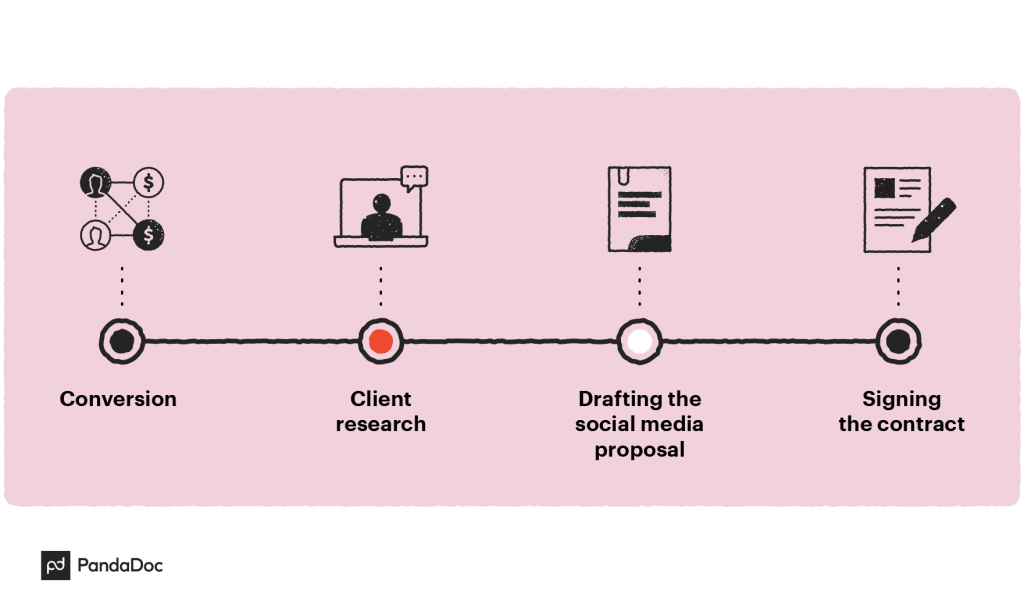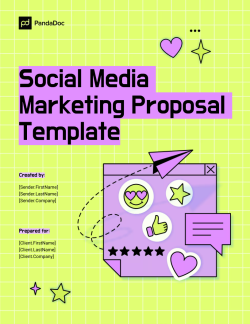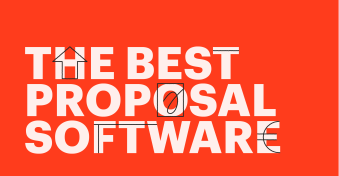Wondering how to write a social media proposal?
In the era of social media marketing becoming the norm, the demand for social media management professionals is soaring.
To stand out in this competitive field and gain more clients, it’s crucial to showcase not only your analytical skills but also present compelling and strategic social media campaign proposals.
Effectively communicating how your proposal will positively impact the client’s business is key to securing clients in this dynamic landscape, and this article will guide you in crafting comprehensive and impactful social media proposals.
Key takeaways
- A social media proposal is a document outlining strategies, services, and deliverables offered by a social media agency or professional to a potential client.
- The social media proposal should be sent during the consideration stage of a sales funnel when potential clients are evaluating service providers.
- Hold a one-to-one discovery session with your client before drafting a social media proposal.
- There are 9 elements of a social media proposal that will win clients.
- PandaDoc’s templates, examples, and samples can help you write a winning social media proposal
→DOWNLOAD NOW: FREE SOCIAL MEDIA PROPOSAL TEMPLATE
What is a social media proposal? A definition
A social media proposal is a document outlining strategies, objectives, and plans for a social media marketing campaign presented to potential clients or stakeholders.
While a social media proposal can double as a contract, it usually outlines what work you’ll do for the client if they wish to hire you.
A business contract usually comes into play after the client accepts your proposal and agrees to your terms.
Think of a social media proposal as a blueprint you present to prospective clients.
Instead of an architect showing a builder how to construct a home, a social media proposal outlines the deliverables, scope of work, milestones, strategies, timeline, and type of content needed to accomplish the business’s social media marketing goals.
In other words, a social media proposal showcases your value to potential clients.
You’re showing them exactly what you bring to the table and that you understand their needs.
Did you know there are now 4.76 billion social media users worldwide, equal to just under 60 percent of the world’s population?
Or that business owners have seen so much success from social media marketing that 97% of marketers say they use social media to engage with their audiences?
All the more reason to get in on the action.
It’s okay to show off a little! New clients want to know they’re in good hands.
How does a social media proposal fit into your workflow?
Social media business proposals are just one part of the sales process.
However, determining where a proposal fits within the sales process can be confusing.
Do I send a social media management proposal before or after signing a contract? What about grant proposals or executive summaries? Where do they fit?
Generally, proposals are sent before both parties sign a contract.
Although a sales workflow is determined by the organization, usually, your social media proposal workflow will include 4 steps:

After your client signs the contract, they start to become loyal customers to advocate for your services.
When to send a social media proposal
A social media proposal is usually sent after a discovery call and summarizes the potential project, its scope, and essential details conveniently in a deck or file.
This is for several reasons.
- During the discovery call, the client and the social media professional or agency discuss the client’s specific needs, goals, and expectations. The proposal is a formal document reinforcing the key points discussed during the call.
- Sending the proposal after the discovery call allows the client to review and validate the discussed details, ensuring that both parties are on the same page regarding the project’s objectives and parameters.
- The proposal acts as a professional and organized way to convey the proposed social media strategy, making it easier for the client to decide about moving forward with the collaboration. It serves as a reference point for the agreed-upon terms and sets the foundation for a more structured and successful partnership in social media management or marketing.
How to create a social media proposal in 14 key steps
A proposal has a lot of different purposes, but there is a right way and a wrong way to write one.
Creating a social media proposal comes down to these key steps:
- Understand client needs: Thoroughly understand the client’s business, goals, target audience, and specific needs through detailed discussions.
- Research and analysis: Conduct research on the client’s industry, competitors, and current social media presence to inform your proposal with relevant insights.
- Define objectives: Clearly outline the objectives of the social media proposal, specifying what the client aims to achieve through the proposed strategies.
- Craft a compelling executive summary: Summarize the key points of the proposal in an executive summary, providing a quick overview of the proposed strategies and expected outcomes.
- Outline proposed strategies: Detail the social media strategies you recommend, including content creation, posting schedules, audience targeting, and engagement tactics.
- Specify deliverables: Clearly list the tangible deliverables, such as social media posts, reports, analytics, and any additional services included in your proposal.
- Propose a timeline: Provide a realistic timeline for implementing the proposed strategies, outlining key milestones and deadlines.
- Budget and pricing: Clearly state the costs associated with your services, breaking down the pricing structure and any additional expenses.
- Address measurement and reporting: Explain how you will measure the success of the proposed strategies, including key performance indicators (KPIs) and reporting frequency.
- Terms and conditions: Clearly outline the terms and conditions of the proposal, including the duration of the agreement, termination clauses, and any other relevant contractual details.
- Include a call to action: Encourage the client to take the next steps by including a clear call to action, such as scheduling a follow-up meeting or signing the proposal.
- Design and formatting: Ensure your proposal is visually appealing and easy to navigate, using professional design elements to enhance its overall presentation.
- Review and edit: Before finalizing, thoroughly review and edit the proposal to ensure clarity, coherence, and accuracy.
- Submit and follow up: Submit the proposal to the client and follow up to address any questions, concerns, or potential modifications.
Why a discovery call is necessary before writing a proposal
Before you start drafting your social media client proposal, you need to speak to your clients about their needs, expectations, and their definition of success in a one-on-one discovery session.
That’s because the perfect social media strategy isn’t “one-size-fits-all.”
You could have two clients in the same niche with different business goals. In the end, a discovery session is always necessary!
A discovery session benefits marketers as well.
In under 10 minutes, you can decide whether or not you can help a new client within their budget or time constraints.
They may even think you provide a service you don’t, and clearing that misunderstanding up can save you time.
Here are some important questions to ask during your discovery session:
- What are your current business or marketing goals for social media?
- What is your target audience? What does your “ideal customer” demographic look like?
- Who are your business competitors? What content do they make?
- How much time and money can you invest in this project?
- Are you new to social media, or do you have an established social media presence?
Now that you have answers to these questions, you can learn how to write a social media proposal.
The template we’re using covers social media project proposals, but we can help you learn how to write a general business proposal or a sales proposal, as well.
You can download this social media proposal example, 40+ other social media templates, and hundreds of business proposal templates on our website.
9 elements to include in a social media proposal
In this segment, we’ll delve into the key components and essential details that make a comprehensive and effective social media proposal, guiding you through the crucial elements for a successful collaboration.
1. Introduction
In business, an introduction sets expectations for the rest of the meeting.
Your goal is to make a great first impression, attract attention, and hook the client.
At the end of your first meeting, you should know what they want from you. Now it’s your turn to prove you were listening by showing you understand their needs.
Here is an example of a stand-out introduction:
Dear [Client.FirstName]
Thank you for considering [Sender.Company] for your social media marketing needs.
I’m glad we had the opportunity to connect so that my team and I could get a clear understanding of your social marketing expectations.
By using social media strategies and implementing procedures based on the results of extensive analysis, the study of social media trends, and the application of specifics unique to [Client.Company], we are confident that we will deliver effective results within your social media channels.
You can use our free social media proposal template to get the job done!
In our social media marketing proposal sample, we used the second-person pronoun “you” because it pulls the reader into the action.
It also helps you come off as more personal.
→DOWNLOAD NOW: FREE SOCIAL MEDIA PROPOSAL TEMPLATE
2. Business and marketing goals
Any good marketing strategy needs a goal to reach.
Otherwise, how will you know if you’ve hit your key performance indicators (KPIs) or search engine optimization (SEO) targets?
Most of the time, your client’s social media goal is to make more money.
There are plenty of ways to do this, so you must narrow down what pain points to hit to achieve that goal.
One of the best ways to structure your client’s needs is by using SMART goals:
- Specific: Are my goals sensible, simple, and significant?
- Measurable: When and how will I know it’s accomplished?
- Achievable: How can I achieve my goal?
- Relevant: Does this goal match my needs?
- Time-bound: Can I accomplish my goals on time?
Let’s use an example.
Let’s say your client wants to make more money from social media, but they have no social media presence.
You decide that the fastest way to do this is by increasing followers or customers. This is the business goal.
Now that we know what the business goal is, we can determine a marketing goal.
At this step, you must connect the business goal to a social media metric.
For example, follower count can relate to the audience growth rate metric and the Number of Customers KPI.
Let’s put all of that together into a SMART goal:
Increase follower count by 10% by the end of next year.
You can put this goal into your introduction portion or directly after.
Some of your clients will want to know which metrics contribute to that goal so you’re both on the same page.
To get to this goal, you would need to add digital marketing and content creation strategies that promote growth for your specific client.
This will be covered in the next section.
3. Scope of work
Go into specifics and leave no stone unturned.
Explain exactly what you’re proposing for each item and break each section down into subsections to remove any doubt.
Marketing agencies are hired to solve problems, and so are freelancers.
Your social media services must explain the issue and how your scope of work will fix those issues.
Social media proposals often include the following (though you don’t need to offer all of these services):
- Social media platforms: Explain why you chose a social media platform, like Linkedin.
- Social media accounts: A client may need more than 1 account on the same platform.
- Social media audits: State how frequent audits can help improve their social presence.
- Content creation and curation: Outline what creative services you offer and why they’re important. Include a content calendar, image creation, and video, among others.
- Posting schedule: Explain that a frequent posting schedule leads to faster growth.
- Brand monitoring: Declare which keywords you’ll monitor and how you’ll monitor them.
- Community engagement: State how often you’ll interact with the client’s community.
- Analytic reporting: Explain the metrics you follow, why, and how often you report.
- Marketing plans: State how marketing can increase their reach. If you’re thinking of adding influencer marketing to your proposal, this influencer proposal template can help.
- Check-ins: Suggest weekly meetings to ensure the client’s needs are met.
Next to each service, provide a price estimate based on the client’s budget.
Social media consultants, marketers, and campaigners may need a more curated template for this section.
You can find a social media consultant proposal, and a digital marketing proposal, in our template library.
4. Competitors
All businesses have competitors, even if they have a product or service that’s entirely new.
We all share the same social media space, so everyone is a competitor for a user’s attention.
However, it’s more likely that your client has a product or service already on the market.
Whether your client wants to sell clothing or promote their services as a social media marketer, they need that special “It” factor that separates them from the rest.
At the same time, they also need to mimic their competitors without ripping them off.
With your expertise, you should be able to find that balance as you work with your clients.
To find your clients’ competitors, start a competitive research analysis to find:
- Who their competitors are
- What products they offer
- Their sales tactics and results
- Their shipping costs, pricing, and perks
- How they market their product
- Their content strategy and the technology they use
- Their social media platforms and presence
Your client can offer a goldmine of information on the topic.
They probably already know who they’re competing with, so ask them what brands they look up to or want to imitate.
In your social media proposal, explain what their competitors are getting right and which social media analytics you can improve to make up for what their competitors lack.
You’ll also provide insight into your client’s flaws.
This feedback can help your clients understand customer expectations, leading to more sales and money!
5. Target audience
Researching your target audience is kind of like snooping on your competitors, except it involves a lot more trial and error.
There are 3 reasons why you want to define your target audience:
- Ensure you’re creating the right content for the right people.
- Create a better understanding of how to make the best content.
- Increase conversion rates.
In your discovery session, ask your client if they know what their current customer looks like.
If they don’t know or don’t have a social media presence, ask what problem their product or service solves.
Then, you can figure out what the target audience cares about or what they like.
At the end of your research, you should have an audience persona that covers who they are, what they like, when they browse social media, where they browse, and why they browse.
6. Project milestones and deadlines
In the “Business and marketing goals” section, we discussed how to find and make goals for your clients that matter specifically to them.
In this section, we explain to the client how we measure success and why these milestones and deadlines work for their industry, product, or services.
We also want to state what we’ll do once we reach those goals or how to pivot if we fall short.
You can put this section right after “Business and marketing goals” or “Scope of work.”
7. Proof of work
Many clients like to shop around before locking in on a proposal, and who can blame them? They want to find the best candidate for the job!
You can prove that you’re the top option by showing proof of your work.
If you have experience in a prospecting client niche or have a wealth of testimonials from high-profile clients, you’ll stand out big time!
The best way to show your value is by providing case studies, reviews, references from past team members, and social media content examples from past clients.
Just make sure you match your portfolio examples with the work your client is offering.
Otherwise, your new client will have no idea how you can help them.
8. Terms of agreement
In this section, you must clarify your contract terms. Your social media proposal can come before the contract or act like one.
Here’s what you should always add in your terms of agreement section:
- Fees: Includes payment frequency: per project, hourly, or retainer.
- Payment: Covers the method of payment, invoices, and payment terms.
- How you work: Discuss your work hours and how the client can reach you.
- Where you work: Do you work remotely, for a company, or in the client’s office?
- Who you work with: State if you have employees working under you or if you hire freelancers. If you work with a team, you may need additional documentation, like a social media partnership agreement.
- Termination: Advise how to end the project early.
It’s a good idea to add a fee to your termination clause. This small edition can protect your bottom line.
At the same time, you should also give yourself the option to leave the project.
Sometimes the scope of a project is too complicated, or you may just dislike the client.
Either way, it’s empowering to know that you have a way out if you need it.
9. Next steps for the client
In the final section of your proposal, write down what options are available to your client.
State clearly what they can and can’t do to improve the chances of signing a contract with you.
Here are a few examples of what the client can do:
- Sign immediately
- Sit on the proposal until the expiration date
- Request changes to the proposal
- Request changes to the contract
- Submit a partial payment
A winning social media proposal example
As we’ve mentioned, a social media proposal outlines the strategies, services, and deliverables that a social media agency or consultant proposes to provide to a potential client.
Below is a complete social media proposal sample:
[Your Company Name] Social Media Proposal
Executive Summary:
We appreciate the opportunity to submit this social media proposal to [Client’s Name]. At [Your Company Name], we specialize in creating and implementing effective social media strategies to enhance brand visibility, engage the target audience, and drive business growth.
Objectives:
Increase brand awareness and reach.
Boost audience engagement and interaction.
Drive website traffic and lead generation.
Enhance overall online presence.
Proposed Services:
1. Social Media Audit
Evaluate current social media presence.
Identify strengths, weaknesses, opportunities, and threats.
2. Competitor Analysis
Analyze competitors’ social media strategies.
Identify key opportunities and differentiators.
3. Strategy Development
Define target audience and buyer personas.
Outline content themes, posting schedules, and engagement strategies.
4. Content Creation
Develop engaging and shareable content.
Utilize multimedia (images, videos, infographics) to enhance engagement.
5. Platform Management
Manage and optimize social media profiles.
Regularly update profile information and images.
6. Community Engagement
Respond to comments, messages, and mentions.
Foster a sense of community around the brand.
7. Paid Advertising
Create and manage targeted social media advertising campaigns.
Optimize ad performance for maximum ROI.
Measurement and Reporting:
1. Key Performance Indicators (KPIs)
Increase in followers and engagement rates.
Website traffic from social media channels.
Conversion rates from social media campaigns.
2. Monthly Reports
Detailed analytics and insights.
Recommendations for continuous improvement.
Budget:
The proposed budget for our comprehensive social media management services is [Amount] per month.
This includes strategy development, content creation, platform management, and monthly reporting.
Next Steps:
We look forward to the opportunity to discuss this proposal further and tailor our services to meet the specific needs of [Client’s Name].
Please feel free to contact us to schedule a meeting.
Thank you for considering [Your Company Name] as your social media partner.
Use PandaDoc’s effective template to create a winning social media proposal
So, when planning how to write your social media proposal, remember to prioritize your client’s needs to enhance the likelihood of transforming them into satisfied and repeat customers who speak highly of your services.
Take advantage of PandaDoc’s social media marketing proposal template for assistance in creating an exceptional proposal!
Frequently asked questions
-
A social media package is a bundle of services provided by social media professionals or agencies, covering a range of things such as content creation, platform management, advertising, and analytics.
These packages are designed to provide clients with a comprehensive and cohesive approach to their social media presence, often offering different tiers or levels to suit varying needs and budgets.
The services within a social media package are structured to enhance brand visibility, engagement, and overall performance on social platforms.
-
Present a social media pitch by clearly articulating your understanding of the client’s goals and needs, highlighting your expertise and relevant experience in managing successful social media campaigns.
It’s always a good idea to use visual aids, case studies, and a well-structured presentation to effectively communicate your proposed strategies, emphasizing the potential positive impact on the client’s business.
-
A social media contract should include clear terms and conditions outlining the scope of services, responsibilities of both parties, payment details, and any specific deliverables or milestones.
Make sure it also covers important legal considerations such as confidentiality, intellectual property rights, and dispute resolution mechanisms.
Disclaimer
Parties other than PandaDoc may provide products, services, recommendations, or views on PandaDoc’s site (“Third Party Materials”). PandaDoc is not responsible for examining or evaluating such Third Party Materials, and does not provide any warranties relating to the Third Party Materials. Links to such Third Party Materials are for your convenience and does not constitute an endorsement of such Third Party Materials.
Originally published September 7, 2021 and has been updated April 16, 2024



